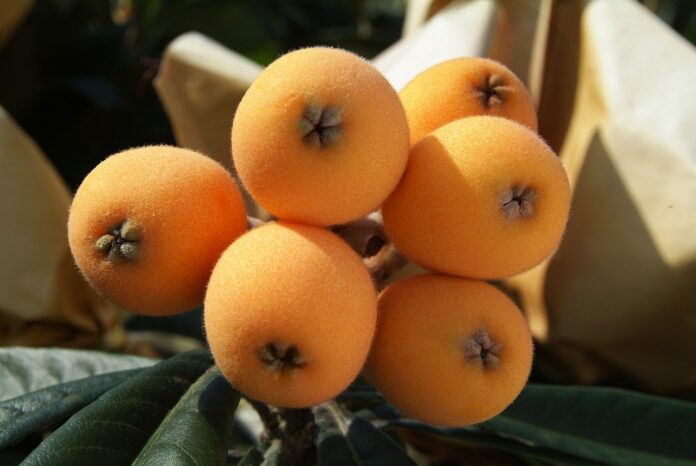Loquat (Eriobotrya japonica) is a subtropical fruit tree native to the southern parts of China, but it is now widely cultivated in many regions, including parts of the Mediterranean, Japan, and the United States. The tree produces small, pear-shaped fruits with smooth skin that ranges from yellow to orange. These fruits have a tangy, sweet-tart flavor, similar to a combination of peach, citrus, and mild apple.
Interesting Facts About Loquats:
- China Roots: The loquat has been cultivated for over 3,000 years, originally in China. It was considered not just a fruit, but a symbol of prosperity and good fortune in Chinese folklore. In ancient texts, the fruit was believed to have medicinal properties, including the ability to treat ailments like coughs and digestive issues
- Replacing Oranges: Loquat trees have a rich history, with cultivation thriving especially in southern California. Charles Parker Taft played a pivotal role in commercializing loquats in Orange County starting in the late 19th century. At one point, it was believed that loquats might rival oranges in profitability. However, by the 1920s, rising costs of land and labor, along with insufficient commercial demand, led to their decline as a major crop. By 1951, loquats disappeared from agricultural production statistics in the region.
- Regional Names: Known as níspero in Spanish-speaking countries, the loquat has several regional names, including biwa in Japan. The name “níspero” is particularly popular in Latin America, where it is deeply integrated into local food culture
- Silk Road Spread: The loquat’s journey across the globe started along the Silk Road. It moved from China to Persia, eventually reaching the Mediterranean and Europe. Traders brought it to the Americas in the 18th century, where it found a suitable climate for cultivation in countries like the United States and parts of South America
- Botanical Family: Loquats belong to the Rosaceae family, which also includes apples, pears, and quinces. They share many similarities with these fruits, particularly in their flavor and texture
- Appearance: Loquats are small, pear-shaped fruits, ranging from yellow to orange. They typically grow in clusters on trees and have smooth, leathery skin. The fruit’s size is about 1-2 inches long, making it easy to handle and eat fresh
- Nutritional Value: Loquats are packed with vitamins A and C, which help maintain healthy vision and skin. They are also high in potassium, which is essential for maintaining proper heart and muscle function, as well as fiber, which supports digestion
- Taste Profile: Loquats have a unique flavor that combines elements of apricot, peach, and citrus. The flesh is both sweet and tangy, with a slightly floral note. The flavor varies by variety, with some loquats being more acidic and others sweeter
- Tree Characteristics: Loquat trees are relatively small, typically growing to about 10-20 feet tall. They have broad, evergreen leaves that are dark green and leathery. The trees bloom in the fall, producing clusters of fragrant white or cream-colored flowers
- Variety: There are different varieties of loquats, with some producing fruits that are more acidic and others that are sweeter. Notable varieties include the “Champagne” loquat, which is known for its mild flavor, and the “Golden Nugget” variety, which is prized for its sweetness
- Loquat in Latin America: In countries like Mexico, Argentina, and Brazil, loquats are not just used in desserts, but also incorporated into savory dishes and salads. In these regions, loquat preserves and syrups are made, and the fruit is a staple in various traditional sweets
- Storage: Loquats are quite perishable. Once ripe, they should be consumed within a few days to avoid spoilage. They can be refrigerated for up to two weeks, but they should be eaten quickly after they ripen for the best taste
- Global Production: Japan is the largest producer of loquats, with extensive cultivation in areas like the Kishu region. Other major producers include Spain, Israel, and the U.S. (particularly California). The fruit thrives in subtropical and mild temperate climates
- Cultural Symbolism: Loquats hold significant cultural symbolism, particularly in Japan, where they are associated with longevity and health. The loquat tree is even celebrated in Japanese poetry, art, and traditional ceremonies
- Loquat Trees as Ornamental Plants: In addition to producing fruit, loquat trees are often planted for their ornamental value. Their large, glossy leaves and fragrant white flowers make them an attractive addition to gardens and landscapes
